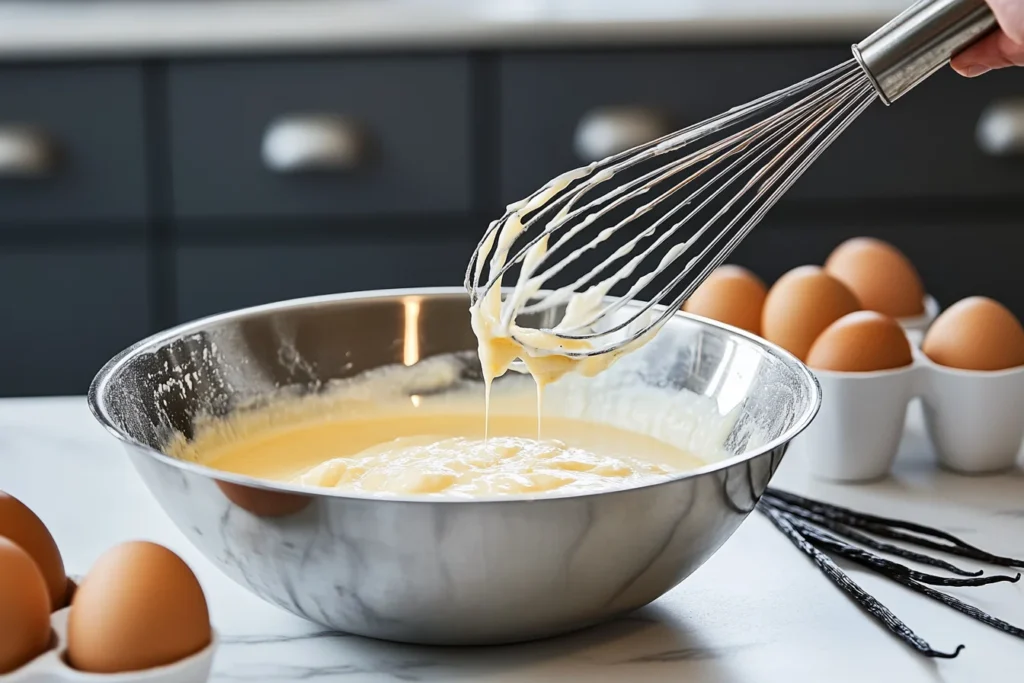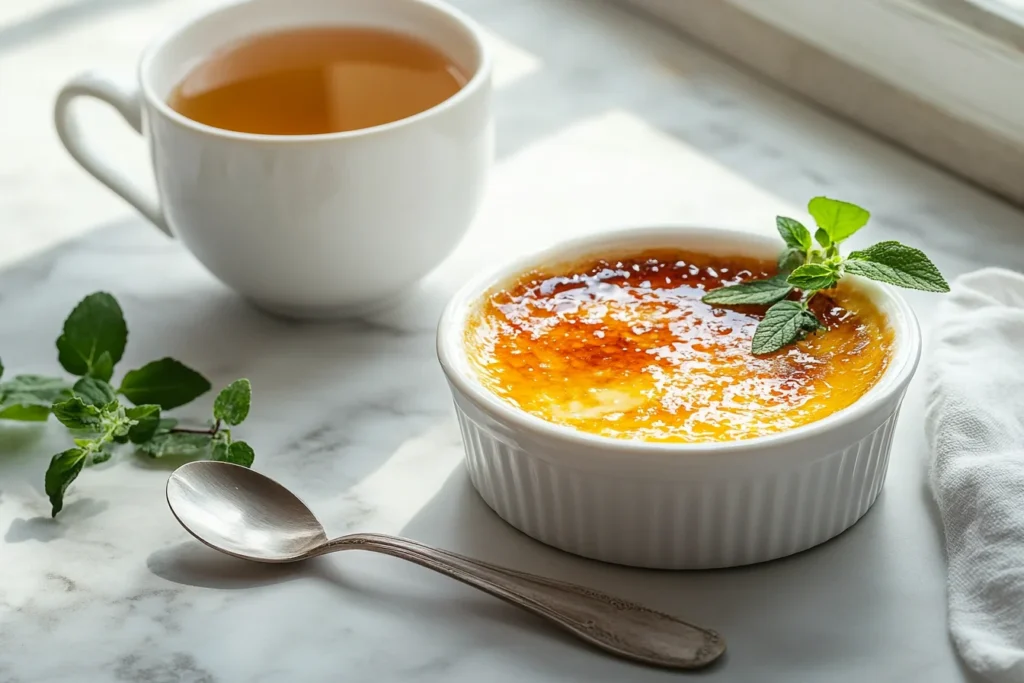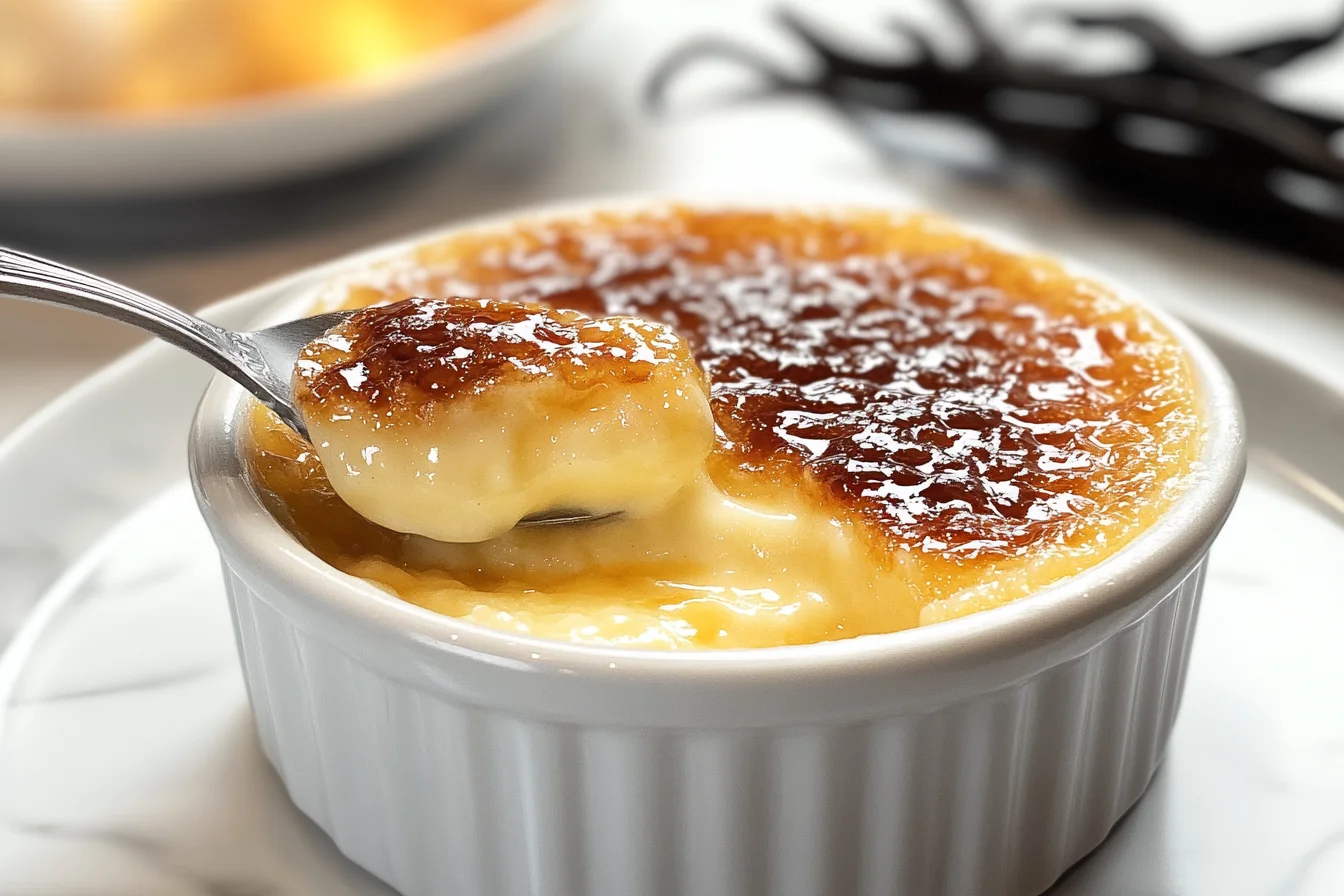Crème brûlée is one of those desserts that captures hearts and tantalizes taste buds across the globe. With its rich, creamy custard base and perfectly caramelized sugar topping, this French classic is a treat that feels indulgent yet elegant. But what does crème brûlée actually taste like? To answer that question, we’ll explore its flavors, textures, aroma, and unique characteristics that set it apart from other desserts. From its history to ingredient highlights and preparation process, this article provides a comprehensive guide to the sensory magic of crème brûlée.
Introduction to Crème Brûlée
Overview of Crème Brûlée
Crème brûlée, often referred to as “burnt cream” in English, is a beloved dessert hailing from France. Its iconic contrast between a silky custard base and a brittle caramelized sugar crust makes it stand out among desserts. With every spoonful, you experience an orchestra of textures and flavors: the satisfying crack of sugar followed by the creamy, sweet custard. It’s no wonder that crème brûlée has become a symbol of culinary sophistication!
Why Its Taste Fascinates Dessert Lovers
One reason crème brûlée captures the imagination of dessert enthusiasts is its perfect balance of flavors and textures. The custard is infused with aromatic vanilla, creating a comforting sweetness that feels luxurious without being overwhelming. The topping, a layer of torched sugar, adds a smoky, caramel-like bitterness that beautifully complements the creamy custard. This combination creates a unique harmony of contrasts that dessert lovers find irresistible.
Brief History of Crème Brûlée
Though crème brûlée is widely associated with French cuisine, its origins are surprisingly diverse. Some claim it first appeared in England as “Trinity Burnt Cream,” while others suggest it emerged in Spain as “crema catalana.” Regardless of its birthplace, the dessert gained widespread popularity in France during the 17th century. Today, it remains a staple in fine dining restaurants worldwide, representing the epitome of dessert artistry.
Components of Crème Brûlée
Main Ingredients
At its core, crème brûlée is built on a simple yet exquisite blend of ingredients that work together to create its signature taste and texture. The custard base consists of heavy cream, egg yolks, sugar, and vanilla. These ingredients are carefully balanced to ensure the custard achieves its rich, creamy consistency.
The heavy cream provides the luxurious silkiness that defines the dessert, while the egg yolks act as a natural thickening agent. Sugar lends a subtle sweetness to the custard, while the vanilla—often derived from fresh vanilla beans or extract—imparts an aromatic warmth. Finally, the caramelized sugar crust, made by sprinkling granulated sugar and torching it to perfection, adds a layer of satisfying crunch.
The Importance of Texture in Taste
What sets crème brûlée apart is its interplay of textures. The first thing diners notice is the brittle layer of caramelized sugar. With a gentle tap of a spoon, the crust shatters, revealing the velvety custard beneath. This textural contrast elevates the eating experience, engaging both the palate and the senses.
Moreover, the custard’s consistency is key to its flavor perception. It should be silky and smooth, without any graininess. When the custard melts on your tongue, it releases the sweetness of the cream and the depth of the vanilla, making every bite feel like an indulgent moment.
Tasting Crème Brûlée
Sweetness and Creaminess
The first taste of crème brûlée is often described as a symphony of sweetness and creaminess. The custard is rich yet light, with a flavor profile dominated by the gentle sweetness of vanilla-infused cream. It’s neither overly sugary nor bland, striking a perfect balance that appeals to even the most discerning palates.
As the custard glides over your tongue, it feels smooth and luxurious, like liquid silk. This creamy texture amplifies its comforting sweetness, making every spoonful feel like a hug in dessert form. It’s a sensation that lingers, leaving you craving another bite before you even finish the first.
Caramelized Sugar: A Perfect Contrast
The caramelized sugar topping is not just for aesthetics; it’s a flavor powerhouse on its own. This thin, brittle layer introduces a smoky, caramel-like bitterness that contrasts beautifully with the custard’s mild sweetness. Together, these flavors create a balanced interplay of light and dark notes that keeps each bite exciting.
When you tap your spoon against the caramelized crust, the satisfying crack is part of the charm. This crunchiness, juxtaposed with the custard’s softness, enhances the sensory experience, making the dessert feel dynamic and multidimensional.
How Aroma Influences Taste
Much of crème brûlée’s appeal lies in its aroma, which prepares your taste buds before you even take a bite. The custard’s vanilla base emits a warm, inviting scent that immediately evokes feelings of comfort and indulgence. Meanwhile, the slightly burnt fragrance of the caramelized sugar adds a touch of complexity, hinting at the robust flavors to come.
It’s no exaggeration to say that the aroma of crème brûlée plays a key role in how we perceive its taste. After all, when the nose is greeted by notes of vanilla, cream, and caramel, the mouth eagerly anticipates the treat ahead.
Comparing Crème Brûlée to Similar Desserts
Crème brûlée often invites comparisons to other custard-based desserts like panna cotta and flan. While panna cotta leans toward a gelatinous consistency and flan features a syrupy caramel sauce, crème brûlée stands out for its indulgent custard and signature burnt sugar topping.
Its flavor profile is also more balanced, avoiding the cloying sweetness of some custards while delivering a depth of taste that feels refined. It’s this combination of texture and flavor that makes crème brûlée a timeless favorite among dessert aficionados.
How It’s Made
Traditional Recipe Process
Making crème brûlée is a meticulous yet rewarding process that requires both precision and patience. The traditional recipe begins by heating heavy cream with fresh vanilla beans or vanilla extract, allowing the flavors to infuse. Meanwhile, egg yolks and sugar are whisked together until pale and creamy, forming the base of the custard.
The warm cream is gradually added to the egg mixture—a process known as tempering—to prevent curdling. Once combined, the custard is strained to remove any impurities, ensuring a silky texture. It’s then poured into shallow ceramic ramekins and baked in a water bath, or bain-marie, which helps maintain a gentle and even cooking temperature.
After baking, the custard is chilled for several hours to set. The final step—the pièce de résistance—is the caramelized sugar topping. Granulated sugar is evenly sprinkled over the surface and torched until golden and crisp, creating the dessert’s signature crunch.

Variations Around the World
While the classic vanilla crème brûlée remains a favorite, creative variations have emerged worldwide, reflecting local tastes and ingredients. In some regions, chefs experiment with flavors like chocolate, coffee, or citrus to add a unique twist. For instance, a matcha crème brûlée combines the creamy custard with the earthy tones of green tea, offering a vibrant alternative.
Fruit-infused versions, such as raspberry or mango crème brûlée, introduce a tartness that complements the dessert’s sweetness. Some daring chefs even incorporate savory elements like herbs or spices, resulting in bold creations such as lavender or cardamom crème brûlée.
Texture variations also abound. In contemporary kitchens, the caramelized sugar topping might be thicker or thinner, depending on the desired level of crunch. Some chefs even experiment with serving crème brûlée in non-traditional vessels, from hollowed-out fruits to edible chocolate cups, for an added touch of drama.
Crème brûlée’s versatility ensures its enduring popularity, proving that this classic dessert can adapt to modern trends while retaining its timeless charm.
Pairing Crème Brûlée
Best Drinks to Accompany It
Crème brûlée’s delicate flavors and creamy texture make it a versatile dessert that pairs beautifully with various beverages. To highlight the dessert’s sweet and rich profile, many opt for non-alcoholic beverages like a warm cup of vanilla-infused tea or a classic cappuccino. The gentle bitterness of coffee balances the custard’s sweetness, creating a harmonious pairing.
For those who prefer a refreshing option, chilled herbal teas such as chamomile or mint can cleanse the palate between bites, letting you savor the distinct flavors of the custard and caramel. Sparkling water with a twist of citrus is another excellent choice, especially if you’re looking for a light complement to the richness of the dessert.

Other Desserts and Sides That Enhance Flavor
While crème brûlée is often enjoyed on its own, pairing it with subtle accompaniments can enhance its flavor profile. Fresh berries like raspberries or blueberries provide a burst of tartness that contrasts beautifully with the dessert’s sweetness. A small side of fruit compote or citrus zest can also bring a refreshing tang to balance the custard’s richness.
For a textural contrast, delicate cookies such as biscotti or shortbread make an excellent side. The crispness of the cookies complements the smooth custard and brittle sugar topping, adding an extra layer of enjoyment to the dining experience.
If you’re hosting a dinner party, consider serving crème brûlée alongside a light fruit salad. This pairing keeps the meal balanced and ensures your guests leave with satisfied palates. Crème brûlée may be simple, but it shines even brighter when thoughtfully paired with complementary flavors and textures.
Popular Questions About Crème Brûlée
What Does Crème Brûlée Taste Like Exactly?
Crème brûlée is a harmonious blend of flavors and textures. The custard tastes rich and creamy with a distinct vanilla aroma, offering a velvety sweetness that feels indulgent without being overpowering. The caramelized sugar topping adds a contrasting layer of smokiness and slight bitterness, creating a perfect balance that’s utterly satisfying.
Each spoonful delivers a mix of crunchy and smooth textures, making the experience both exciting and comforting. For many, crème brûlée evokes a sense of luxury and refinement while remaining approachable.
Is Crème Brûlée Always Sweet?
Yes, crème brûlée is traditionally a sweet dessert, but its sweetness is subtle and refined. The burnt sugar topping provides a hint of bitterness that prevents the dessert from feeling overly sugary. While the custard itself leans towards sweetness, it’s balanced by the aromatic notes of vanilla and cream.
In modern adaptations, chefs occasionally experiment with savory ingredients, such as herbs or spices, creating unconventional versions. However, the classic crème brûlée remains a sweet indulgence.
Does the Caramel Top Affect the Flavor?
Absolutely! The caramelized sugar crust is essential to the flavor profile of crème brûlée. It provides a smoky, slightly bitter contrast to the creamy custard, enhancing the overall balance of the dessert.
The crust’s texture also plays a critical role. The satisfying crack as you break through it adds to the sensory delight, while the caramelized sugar shards introduce a crispy bite that complements the silky custard beneath. Without this topping, crème brûlée would lose much of its unique appeal.
Can Crème Brûlée Be Made Vegan or Gluten-Free?
Yes, crème brûlée can be adapted to accommodate dietary restrictions. For a vegan version, substitutes like coconut cream or cashew milk can replace heavy cream, while egg yolks can be swapped for plant-based thickeners like agar-agar or cornstarch. These alternatives maintain the dessert’s creamy consistency while offering a unique twist on its flavor.
As for gluten-free adaptations, the traditional recipe is naturally gluten-free, as it contains no wheat-based ingredients. This makes it a fantastic choice for those avoiding gluten without sacrificing flavor or indulgence.
What Makes Crème Brûlée So Special?
Crème brûlée’s charm lies in its simplicity and sophistication. Few desserts can match the textural contrast of its smooth custard and crisp sugar crust. Its flavor profile, a delicate balance of sweetness, creaminess, and caramelized bitterness, appeals to a wide range of palates.
Moreover, crème brûlée is versatile, lending itself to countless variations without losing its essence. Whether served in a fine dining restaurant or crafted at home, it has a timeless elegance that makes every bite feel like a special occasion.
Conclusion
Why Crème Brûlée Stands Out
Crème brûlée is more than just a dessert—it’s an experience that delights the senses. From its simple yet exquisite ingredients to its masterful balance of textures and flavors, it embodies culinary perfection. The interplay between the smooth custard and the brittle caramelized sugar crust creates a sensation that’s both indulgent and unforgettable.
What truly sets crème brûlée apart is its versatility. Whether enjoyed as a classic vanilla custard or reimagined with bold flavors like matcha or lavender, it remains a favorite in kitchens and restaurants around the world. Its universal appeal lies in its ability to be both luxurious and comforting, making it a dessert that feels equally at home in a casual gathering or a fine dining setting.
Encouraging Readers to Try It
If you’ve never tasted crème brûlée, you’re missing out on one of life’s simplest pleasures. Whether you try making it at home or order it at your favorite restaurant, this dessert is sure to leave a lasting impression. Its unique combination of creamy sweetness and caramelized crunch is nothing short of magical.
Crème brûlée invites you to slow down and savor the little things—a reminder that life’s sweetest moments are often found in the simplest joys. So, go ahead, take that first crack of the caramelized top, and let the velvety custard below transport you to dessert heaven.


4 thoughts on “What Does Crème Brûlée Taste Like? A Sensory Delight Explained”